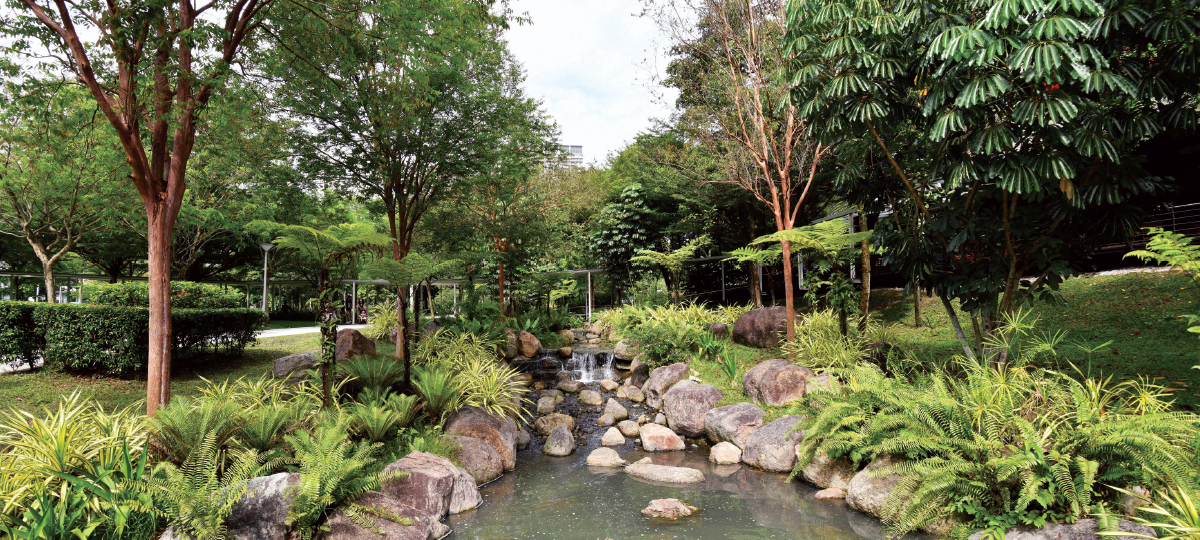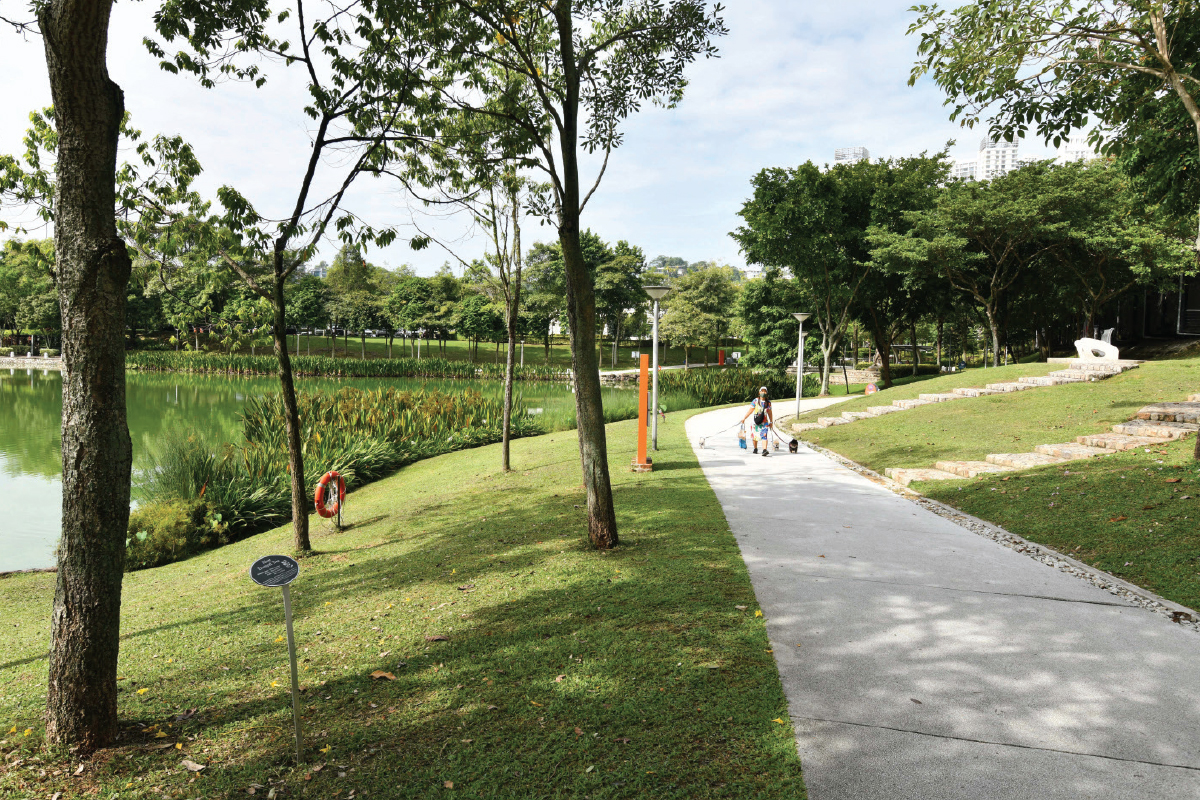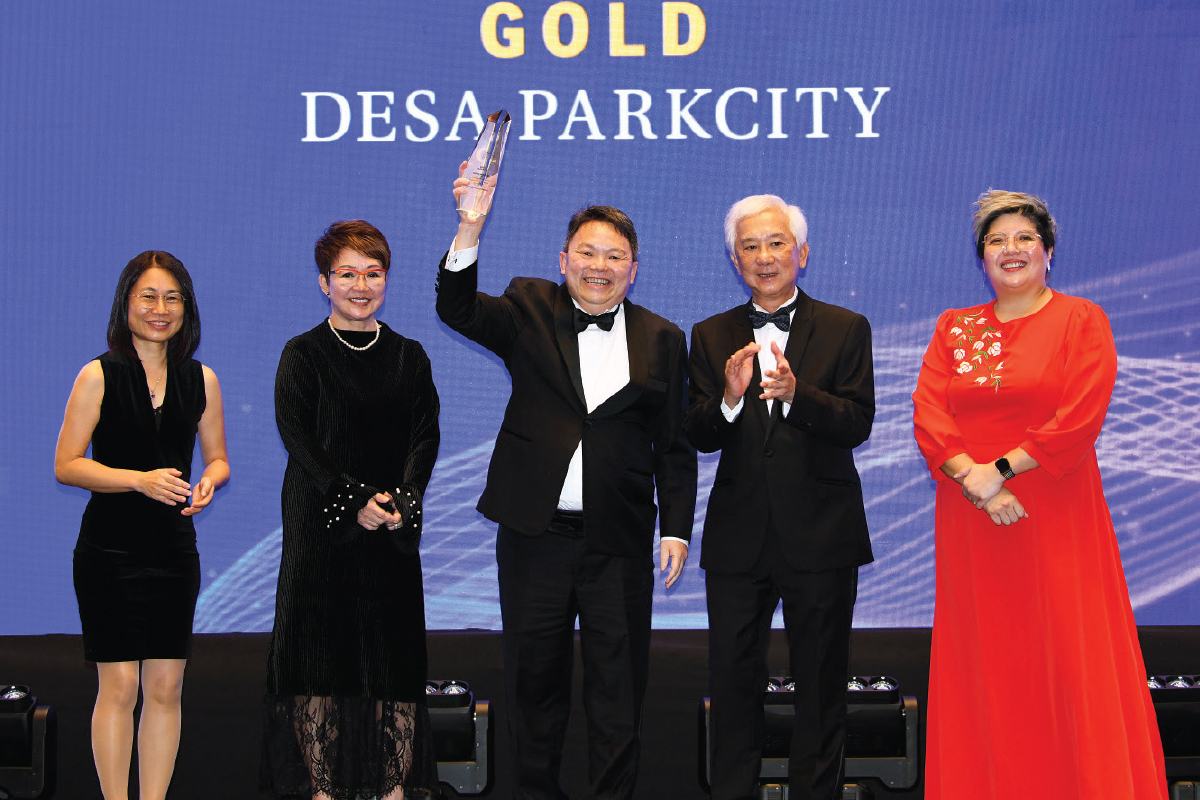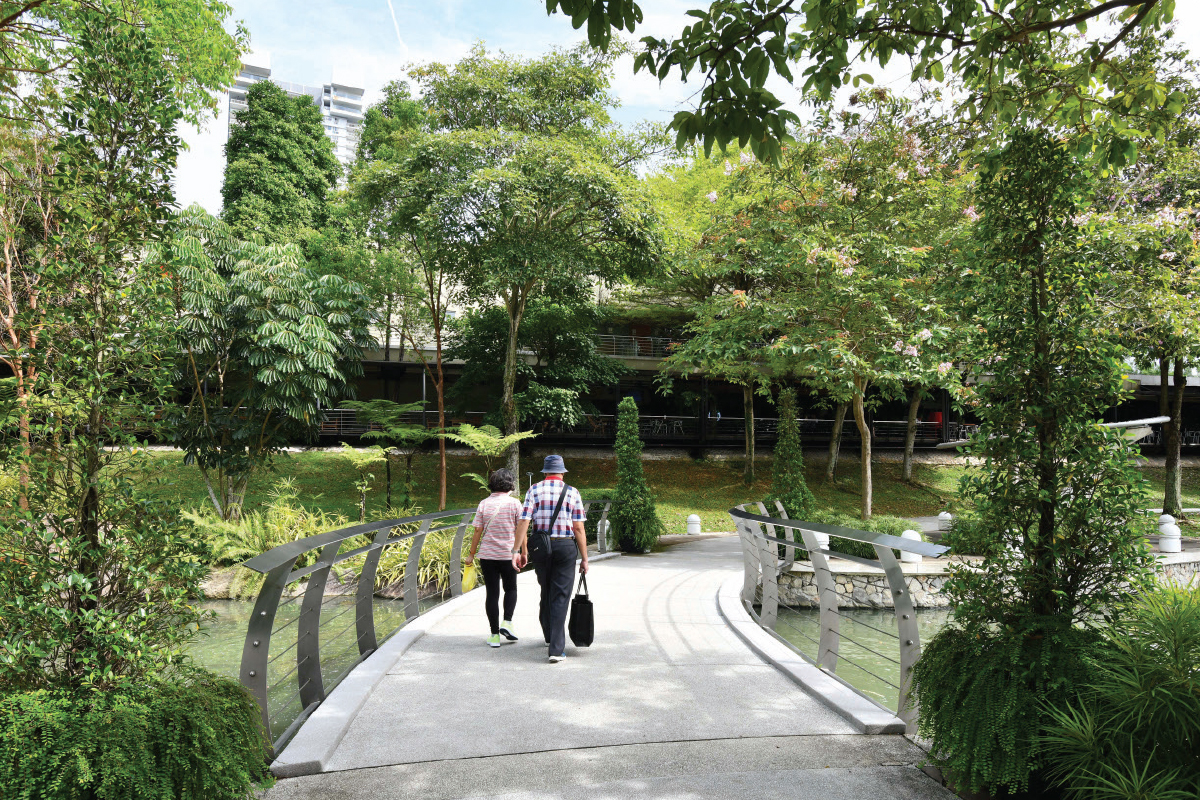
This article first appeared in City & Country, The Edge Malaysia Weekly on August 22, 2022 - August 28, 2022

It’s coming to about 11am and you still see people walking around the Central Park. It’s amazing,” says ParkCity Group director (township management) Sukhdev Singh, as he points to another park-goer from where we are seated in the sales gallery at The Waterfront. It may be a rare sight for people to be strolling about at midday in our humid tropical climate, but that is evidently not the case at Desa ParkCity in Kuala Lumpur.
This phenomenon is a result of its master developer ParkCity Group’s vision and thoughtful planning of the township from the get-go. A barren quarry in its previous life, the site has been transformed into a verdant and walkable community.
“The truth is, without thinking about sustainability back then, we had to think of ways to bring the temperature down. The only way was to plant a lot of trees. Having lakes also helps to cool down the environment,” says ParkCity Group’s CEO Datuk Joseph Lau.
At the heart of the master plan is the 13-acre Central Park that is complemented by a man-made lake, which not only draws the township’s residents but also attracts visitors, as it is one of the few dog-friendly parks in the Klang Valley.
“The Central Park is a core feature where everyone can enjoy and get together in the middle of the whole development, and where they can walk and have a healthy lifestyle. Today, we even see people bringing not only their dogs but also parrots, cats, ducks and all kinds of pets to the park,” says Lau.
The six-acre Central Park Lake, together with the natural lake at the future ParkCity TownCenter, is a catchment area designed to mitigate flooding as well as irrigate the surrounding vegetation.
“The design aspect of it is to ensure long-term sustainability. Everyone sees this lake as a recreational place, but they may not realise that it is actually a retention pond,” says ParkCity Group director (sales) Loh Poh Khim.
“Control mechanisms have been put in place to manage overflows. These days, we keep hearing about floods everywhere, but we don’t have this issue here.”
The landscape planning at Desa ParkCity is part of the fabric of its New Urbanism town planning approach, which encourages walkability to essential community destinations such as parks, shops, school and hospital. This also reduces the need for cars, thereby decreasing the carbon footprint of the community. “We made sure that the walkways are wide, are shaded nicely and are comfortable for people to walk, and that it takes them five to 10 minutes to go anywhere they want to go [within the township],” says Lau.
Launched in 2002, Desa ParkCity is now almost 80% developed, with 3,500 units of completed properties and home to a population of about 22,000. Its amenities include Plaza Arkadia, The Waterfront, ParkCity Medical Centre, The International School @ ParkCity, The ParkCity Club and The SportsCenter.
“We wanted to do something different from other developers. Instead of just selling bricks and mortar, we wanted to give them a lifestyle. So, people can actually live, work and play in this township,” says Loh.
To complete the township, ParkCity Group is focused on building the community. “We want to create something that has a heart and soul, because at the end of the day, for the township to continue to thrive, it is with everyone’s involvement,” says Lau.
Desa ParkCity’s success story has seen it win the Gold award in the Landscape Planning category of The Edge Malaysia-ILAM Malaysia’s Sustainable Landscape Awards as well as the Editor’s Choice Award at The Edge Malaysia Best Managed & Sustainable Property Awards 2022.
The township’s Central Park won Gold in the Specialised Categories at the Best Managed & Sustainable Property Awards 2020.
Something different
According to Lau, Desa ParkCity was born out of wanting to do things differently. “Rather than just rows and rows of houses, we wanted to do something different in the Klang Valley.
“It took us a while to find the right piece of land in Kuala Lumpur. Then, this one came up, 14km to downtown KL and the site was big. I suppose being a quarry, a lot of people wouldn’t know what to do with it. But we saw that we could create something very interesting out of it, as a quarry can have its advantages due to the topography of the site, which can provide an opportunity to create the whole environment.”
Sukhdev says, “The initial challenge, of course, was to convert the quarry site into a beautiful green park that is sustainable for the long term.”
Despite being both challenging and costly, the task of cleaning up the environment and repairing the hill slopes of the former quarry was completed, and the developer began site earthwork and building construction in June 2002.
Nonetheless, the process was a lot of trial and error, says Lau. “Because trees cannot grow on rocks, we needed to make sure the topsoil was high enough, as plants and trees need a certain depth to grow properly. So, that was a challenge.”
The entire site, which was arid and unsuitable for vegetation, underwent extensive subsoiling and topsoiling works to regain the natural ecosystem. The landscape team even invented its own mix-soil treatment and planting technique through many trials and errors.
“We also had to learn by trial and error what types of trees can be planted,” says Sukhdev. “As trees that are a little bit deep-rooted cannot grow in this soil.”
As a result of the team’s continuous effort, Desa ParkCity is a thriving parkland community with 75 native species and 50 non-native species of plants and trees at the Central Park. Some of the rarer species include the Belian Tree and Sausage Tree.
Desa ParkCity also has its own softscape nursery, which was set up in 2014 to cater to some of the township’s immediate planting needs. In addition to nurturing hundreds of shrubs, the nursery also produces its own eco-friendly fertiliser from composting organic matter such as the abundance of dry leaves and branches that are swept away daily.
Due to the softscaping innovations at Desa ParkCity, local authorities such as Kuala Lumpur City Hall, Petaling Jaya City Hall and Shah Alam City Council have conducted field studies at the township, using its landscape as a benchmark.
To date, about 30% of the verdant township has been designated as green spaces, including eight acres of The West Park and a strip of land on the eastern hillocks that has been converted into The East Park.
“The West Park was actually allocated to a government school but since it was [undeveloped], we converted it into a landscaped garden park because to the west of the township, we have condominiums, namely The Westside One, The Westside II, Westside III, South Brooks and Sofiya, and we want the residents there to be able to enjoy that part as a park,” says Loh, adding that The West Park was also created for residents who prefer a dog-free environment.
At its strata landed developments, the developer turned the often-overlooked back lanes of houses into linear parks for people to enjoy. In fact, the first homes built in Desa ParkCity were one of the first landed strata properties in the country.
“The back lanes of typical shophouses are usually unkempt and dirty, but we wanted it to be a space that people can enjoy. And that’s what we did at Plaza Arkadia, for example,” says Lau.
A learning process
Landscape maintenance is not without challenges. “It is one of those things that we just have to go through and learn. We have to constantly monitor everything, from the water quality to the slopes. But then again, nothing is without challenges, and I must say we all enjoy doing it,” says Lau.
For example, man-made lakes do not have a water-circulating ecosystem in place to prevent water from being contaminated by natural agents, so a bio-filtration system has to be used at the Central Park Lake. To further improve water quality, aquatic plants were introduced to naturally balance the ecosystem, says Sukhdev.
“As we go along, we learn. Sometimes, we learn that certain species of trees may not be suitable. Then, we get the right types of trees and maintenance becomes easier. Whatever we try to do, we try to lower the maintenance of it,” he adds.
The operating cost of the upkeep of all the common areas in Desa ParkCity was RM3.2 million last year. Meanwhile, the capex for the softscape and hardscape at the Central Park came to RM7.5 million. After the park was completed in 2010, the cost of upgrading works was placed under operating costs.
Meanwhile, the developer is looking at tackling traffic woes in the township. “The truth is, the residents don’t cause the congestion as they tend to walk, cycle or use electric mobility. What we see is people from outside coming in, especially on weekends, which causes the congestion. It is a chicken-and-egg situation because we want them to come, but it can become quite overwhelming,” says Lau.
“That is why we are looking at creating another urban town park. It will be another nice park with retail and residential components around it. This is to help disperse the traffic from the other retail areas. As this new park is very near where the exit and school is, it can also help prevent cars from coming to the centre of the development.”
The new park will probably take another year or two to complete, and it will be within walking distance for the residents, he adds.

It takes a village
Recognising the importance of cultivating a sense of ownership and belonging among the community, ParkCity Group, together with the residents, organise a monthly initiative call “plalking”, an activity that combines walking and picking up litter.
Loh says, “It is essentially to cultivate a sense of belonging. We find that this is a more effective way in terms of maintenance. Also because they know that if the place is [well maintained], their property value goes up.”
Units of the first phase — Nadia Parkhomes, which was launched in 2002 with prices starting from RM400,000 — are going for no less than RM2 million on the subsale market today.
Another recent initiative by the group is putting up taxonomy tags for the trees at the Central Park. “The day we implemented it, we saw a lot of people standing around the signage to read them. I think the taxonomies are a good example of bringing this sense of ownership to the next level for the community. This is the long-term direction that we are heading towards,” says Sukhdev.
Once all the land parcels in Desa ParkCity have been fully developed, the maintenance of the infrastructure and various amenities in the township will eventually be handed over to the city council. “For the longer term, we will have to see how we can get the community to also be involved in helping us maintain the Central Park, and how we can work together with the city council to make sure the park is maintained at a very high level,” he says.
According to Lau, ParkCity Group is here to stay. “We are not going anywhere. Our office is here, and this township is important to us. We are also interested in the township because we have vested interests. The school, for example, provides recurring income and we have expanded it to be able to accommodate up to 2,000 students.
“The Waterfront also belongs to us and provides us with recurring income. So, it is of great interest to us to make sure the township is maintained properly.”
He adds that the company is considering the possibility of having a sinking fund for the management of the common areas in the long term. “That would be the ideal situation, where every property we sell [contributes] to a sinking fund, and that everyone knows that the fund is used to manage the common areas in the future.
“Meanwhile, ParkCity Group will be here a long, long time. For us, the township is who we are, we are not going to say it is not our responsibility. It is our DNA, our heart and soul.”
Save by subscribing to us for your print and/or digital copy.
P/S: The Edge is also available on Apple's App Store and Android's Google Play.






